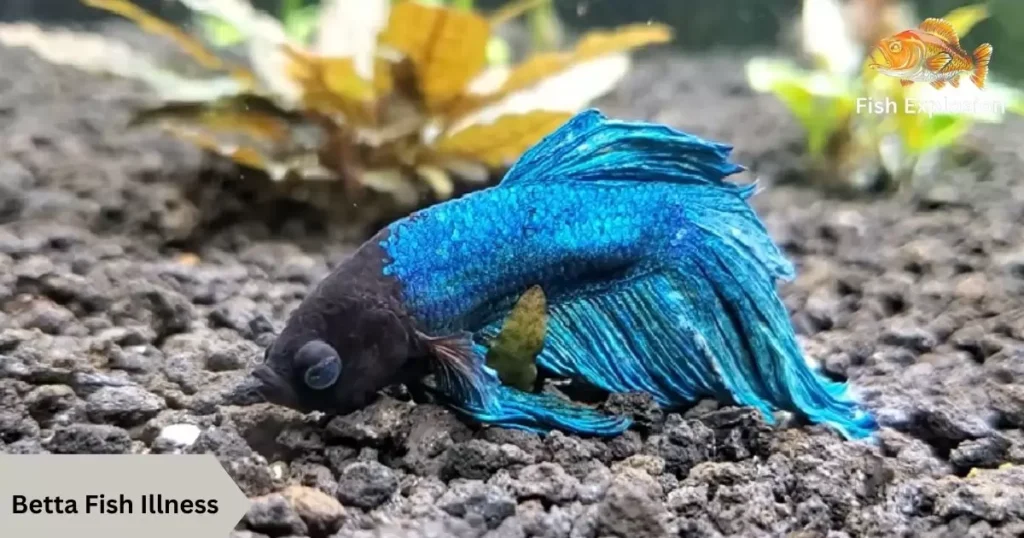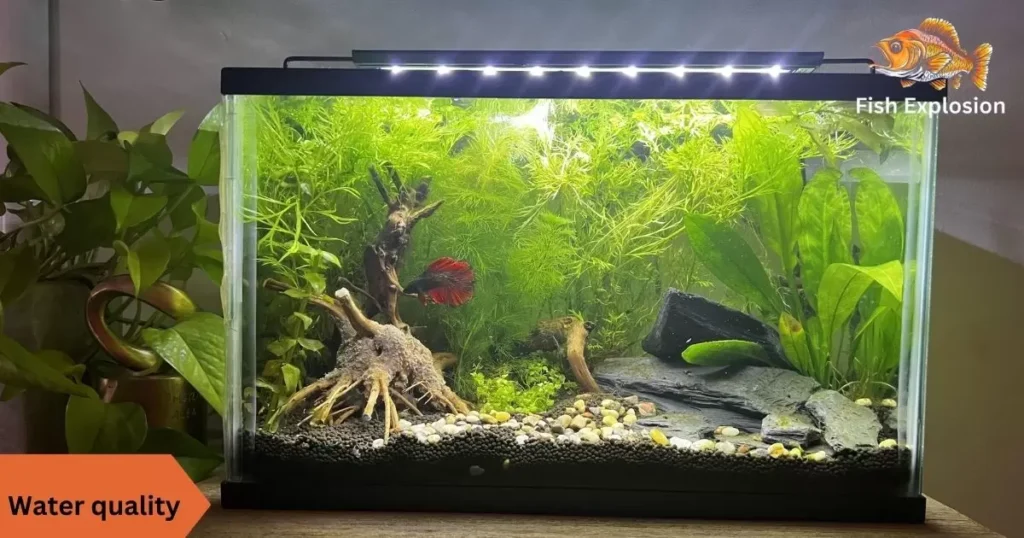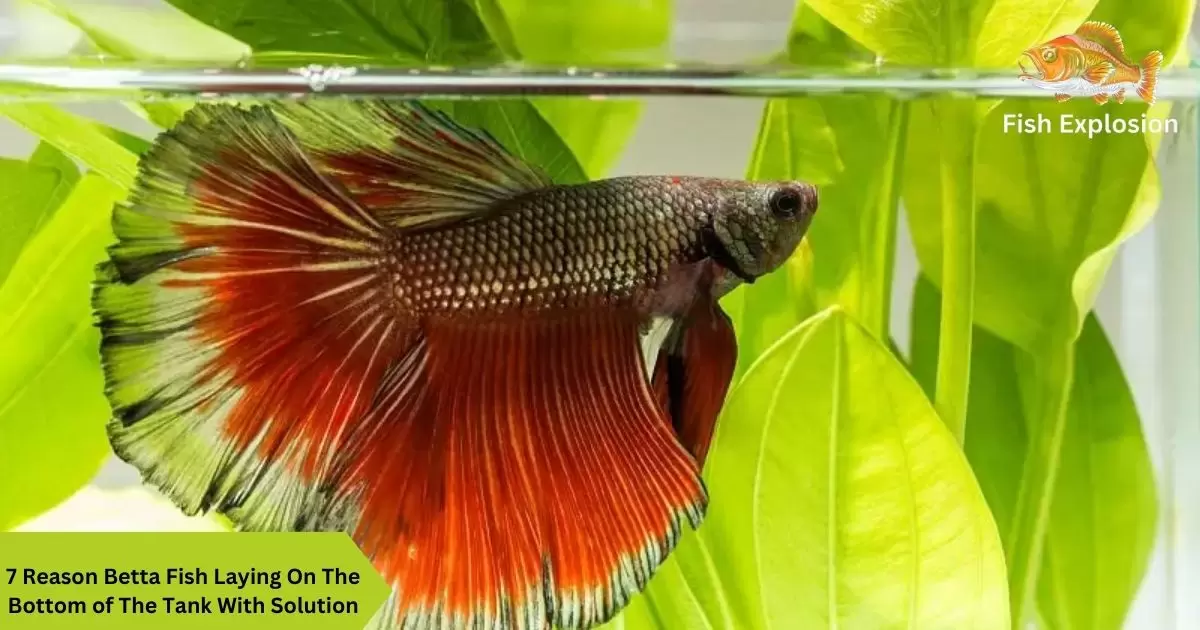Seeing your betta fish lying motionless at the bottom of the tank can be alarming. There are several possible reasons for this behavior, including poor water quality, temperature issues, lack of oxygen, disease, old age, overfeeding, and stress. Solutions include performing regular partial water changes, using a heater to maintain ideal temperatures between 76-82°F, adding an air stone or filter for surface agitation, treating with medication if disease is suspected, providing a varied diet with high-quality foods, rearranging decor to reduce stress, and being mindful of the betta’s lifespan of 2-5 years. Addressing the underlying cause promptly can help revive your betta and prevent serious health decline.
1. Betta Fish Illness

Poor water quality, stress, or pathogen exposure are some of the factors that can cause sudden illnesses in betta fish. Common afflictions include fin rot, velvet, pop-eye, and infectious diseases like columnaris or mycobacteriosis.
Symptoms may include clamped fins, loss of appetite, lethargy, abnormal coloration, and labored swimming or breathing. Maintaining a clean, cycled tank with stable water parameters and providing proper nutrition are crucial for prevention.
Treatment: if illness does occur, promptly treating with appropriate medications like antibiotics or antifungals is essential, as is quarantining to prevent spread to other fish. Perform regular partial water changes and ensure optimal water quality. Treat with recommended medications at the first signs of disease for the best chance at recovery.
2. Overheating
Overheating can be a serious issue for betta fish, as they are tropical species that require specific water temperature ranges. Bettas thrive in temperatures between 76-82°F (24-28°C), and deviations outside this range can cause stress and health problems.
If the water gets too warm, above 86°F (30°C), bettas can become lethargic, lose their appetite, and have difficulty breathing.
Prolonged exposure to high temperatures can lead to more severe issues, like organ failure and even death. Heat buildup can occur due to factors like high ambient room temperatures, inadequate tank insulation, or malfunctioning heaters. Overheating also increases bacterial growth and depletes oxygen levels, compounding the risk to your betta’s wellbeing.
Preventative measures like using an aquarium chiller or fan can help regulate temperatures during hot summers.
Treatment: To address an overheating tank, take immediate steps to gradually cool down the water temperature. Perform a partial water change with cooler, dechlorinated water, being careful not to drastically shock your betta. Consider relocating the tank to a cooler area or investing in an aquarium chiller or fan to maintain optimal temperatures.
Read More: “Can You Put a Male and Female Betta Together?”
3. Water quality

Maintaining good water quality is essential for the health and well-being of betta fish. Poor water conditions can lead to stress, illness, and potentially fatal consequences for these sensitive tropical fish.
Ammonia, nitrites, and nitrates are key water parameters that must be monitored and kept within safe levels. Regular partial water changes, using a quality dechlorinator, and having an established nitrogen cycle are crucial.
Overfeeding, decaying plant matter, and a lack of maintenance can quickly foul betta tanks. Visual signs of declining water quality include cloudy water, foul odors, and algae blooms.
Treatment: Test water parameters weekly and perform partial water changes as needed to maintain safe levels. Vacuum the gravel during water changes to remove debris and detritus that can pollute the water. Consider using live plants and beneficial bacteria supplements to help establish a stable nitrogen cycle.
4. Fatigue
Fatigue is a common issue that can affect betta fish, often manifesting as lethargy and a lack of energy. Overexertion from constant swimming against strong currents is a frequent cause of fatigue in these labyrinth fish.
Poor water quality, bacterial infections, and inadequate nutrition can also contribute to feelings of exhaustion. In some cases, fatigue may be a symptom of a more serious underlying condition, like organ disease or old age. Prolonged fatigue can weaken a betta’s immune system, making them susceptible to further health problems. Observing changes in behavior, like resting more frequently or struggling to reach the surface, may indicate fatigue.
Treatment: Ensure the betta’s environment has gentle water flow and plenty of resting spots near the surface. Temporarily reduce tank maintenance and water changes to minimize disturbance during recovery periods. Offer a variety of high-quality foods and consider supplements to boost energy and immunity.
5. Old age
Betta fish have a relatively short lifespan, typically living 2-5 years with proper care. As they reach old age, bettas may exhibit signs of declining health and vitality. Their vibrant colors may fade, and they can become lethargic and lose their appetite.
Older bettas are more prone to diseases, and their immune systems weaken over time. Swimming may become labored as they struggle to reach the surface for air. Careful observation is key to identifying age-related issues versus potentially treatable illnesses.
Treatment: Provide easily accessible resting places near the water surface to reduce swimming exertion. Maintain stable, optimal water conditions to minimize stress on aging bettas.
Consider supportive care like vitamin supplements and high-quality, easily digestible foods.
6. Overcrowding
Overcrowding is a common mistake that can severely impact the health and wellbeing of betta fish. These territorial fish require ample space and should ideally be housed alone in a minimum 5-gallon tank.
Cramped quarters lead to increased stress, aggression, and the spread of disease among bettas. Overcrowded tanks also make it difficult to maintain stable water parameters due to excess waste production.
Poor water quality from overcrowding can cause fin rot, bacterial infections, and other health issues. Signs of overcrowding include aggressive behavior, hiding, loss of appetite, and deteriorating water conditions.
Treatment: Provide adequate space by housing bettas individually in properly sized aquariums or spacious, divided tanks. Perform frequent partial water changes to dilute waste and maintain water quality. Add live plants, hiding spots, and line-of-sight breaks to reduce stress in cramped environments.
7. Food Diet
A nutritious and varied diet is crucial for the overall health and vitality of betta fish. Bettas are carnivores and require a high-protein diet consisting of live, frozen, or quality dried foods.
Overfeeding or providing an unbalanced diet can lead to issues like obesity, constipation, and organ problems. Live foods like brine shrimp and bloodworms make excellent treats but should be fed in moderation.
Variety is key, so rotate between different high-quality pellets or flakes formulated for bettas. Offering a well-rounded diet helps support vibrant colors, energy levels, and a strong immune system.
Treatment: Feed a variety of high-quality pellets, flakes, and occasional live or frozen treats. Provide only what your betta can consume in 2-3 minutes, 1-2 times per day. Fast your betta for one day per week to allow for proper digestion and prevent obesity.
Top 10 Most Fascinating Types of Betta Fish

The top 10 most fascinating types of Betta fish offer a mesmerizing array of colors, shapes, and sizes, from the elegantly flowing fins of the Veiltail to the dramatic spikes of the Crowntail and the expansive spread of the Halfmoon.
Unique variants like the Elephant Ear Betta stand out with their oversized fins, while the Giant Betta impresses with its substantial size.
Each type brings its own distinctive beauty to the aquarium, making Bettas one of the most beloved and visually stunning species for fish enthusiasts.
- Veiltail Betta: Identified by their long, flowing tails that fall down like a veil, Veiltail Bettas are among the most common and easily available types.
- Crowntail Betta: With spiky, crown-like extensions on their fins, Crowntail Bettas display a dramatic and regal appearance that sets them apart.
- Halfmoon Betta: These Bettas boast a tail that fans out in a perfect semicircle, resembling a halfmoon, showcasing vibrant colors and full fins.
- Plakat Betta: Plakats are characterized by their short, traditional fins, reflecting their wild ancestry, and are known for their heightened activity and aggression.
- Double Tail Betta: This type features a unique split in the tail fin, creating the illusion of having two tails, which adds to their ornamental appeal.
- Delta Tail Betta: Delta Tails have tail fins that spread wide but less than halfmoons, forming a shape similar to the Greek letter delta (∆).
- Elephant Ear Betta/Dumbo Betta: Named for their oversized pectoral fins resembling elephant ears, these Bettas are distinctive and highly sought after for their unique appearance.
- Rose Tail Betta: Rose Tails are known for their excessive finnage that overlaps and folds, resembling the petals of a rose, making them stunningly beautiful but also prone to fin issues.
- Feather Tail Betta: Even more elaborately finned than Rose Tails, Feather Tails have fins that look like delicate feathers, creating a fragile and ornate appearance.
- Giant Betta: Giants are exactly what their name suggests, significantly larger than typical Bettas, offering the same beautiful colors and fin types but on a grander scale.
The Betta Fish Tank Mate Guide: What Works and What Doesn’t
When setting up a community tank with Betta fish, selecting compatible tank mates is crucial due to the Betta’s territorial nature. Peaceful, non-aggressive species that don’t resemble Bettas or compete for their territory, such as small schooling fish like neon tetras or bottom-dwellers like Corydoras catfish, can coexist harmoniously.
However, brightly colored or fin-nipping fish, as well as other male Bettas, should be avoided to prevent stress and aggression.
Ensuring ample space, hiding spots, and a well-structured environment further supports peaceful cohabitation, making the Betta’s integration into a community tank both successful and visually appealing.
FAQ’s
What should I do if my betta fish is lying on the bottom?
If your betta fish is lying on the bottom, check the water quality and temperature immediately, as poor conditions are common stressors.
Why do my betta fish keep sinking to the bottom of the tank?
Betta fish may sink to the bottom due to a swim bladder disorder, often caused by overfeeding or constipation.
What do you do when a fish is lying on the bottom of the tank?
When a fish lies at the bottom, ensure optimal tank conditions, observe for other symptoms, and consider a period of fasting if overfeeding is suspected.
How do you treat a sick betta fish?
To treat a sick betta fish, identify symptoms, isolate the fish if contagious, adjust water conditions, and consult a vet for specific treatments like antibiotics for infections.
Conclusion
In the enchanting world of aquariums, the sight of a Betta fish gracefully navigating its aquatic realm is truly mesmerizing. However, when these vibrant creatures retreat to the tank’s bottom, it signals a plea for attention. This behavior often stems from various causes, ranging from the benign, like sleep or relaxation, to more concerning issues such as water quality problems, stress, illness, or even the natural aging process.
Addressing these issues requires a blend of observation, care, and sometimes, medical intervention. By ensuring pristine water conditions, a balanced diet, and a stress-free environment, we can often restore our Betta’s buoyant spirit. In more complex cases, seeking expert advice becomes imperative.
Remember, the well-being of our aquatic companions lies in our vigilant care and empathy, transforming challenges into opportunities to foster a thriving underwater sanctuary where every Betta can flourish at the water’s surface, rather than seeking solace at the bottom.
With three years of dedicated expertise in the niche of fish, my domain knowledge encompasses breeding, habitat maintenance, health management, and sustainable aquaculture practices, ensuring optimal outcomes in the aquatic realm.











